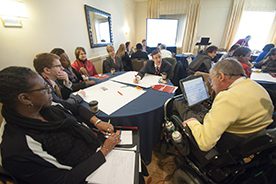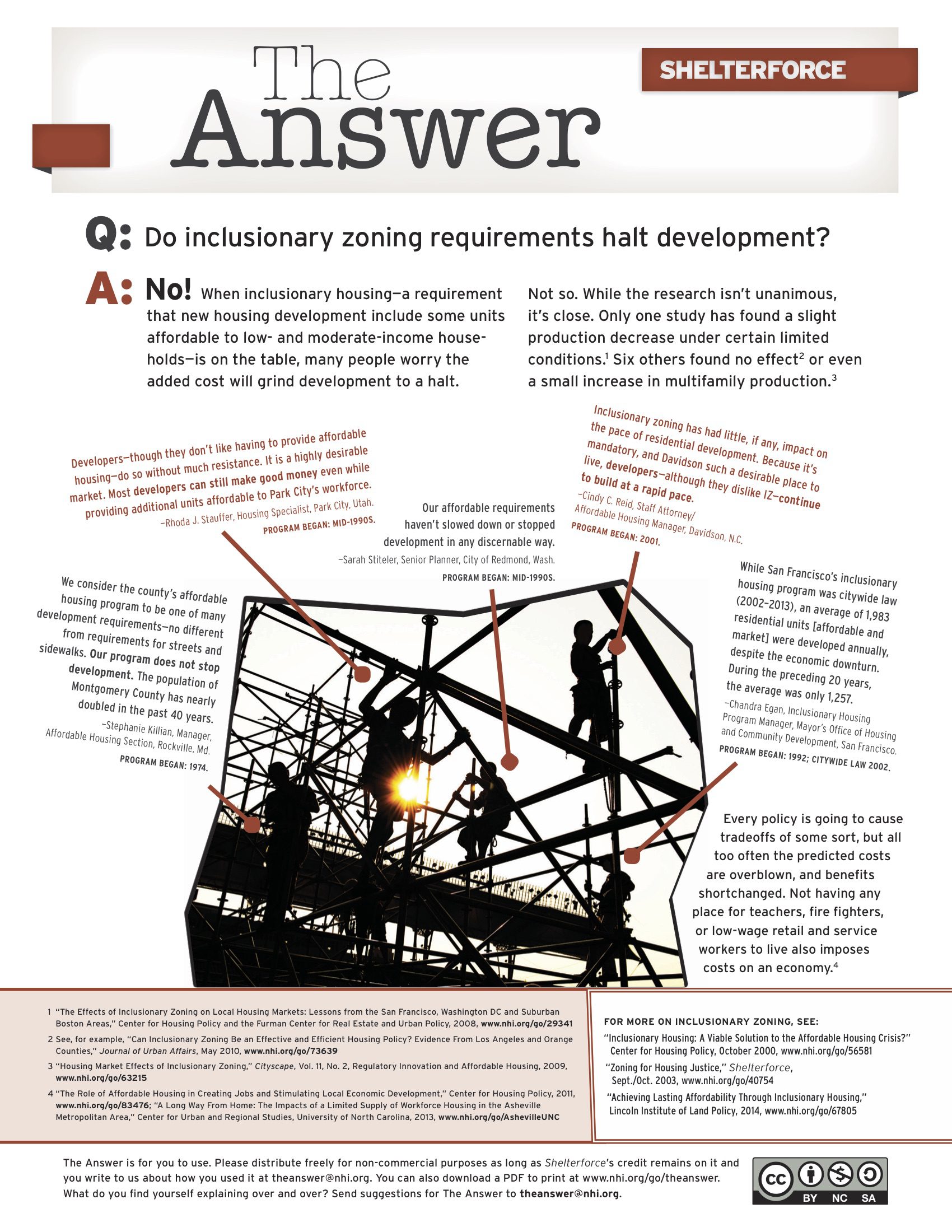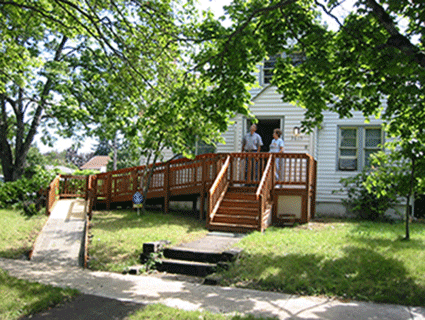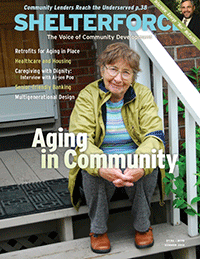
Photo courtesy of the National Community Reinvestment Coalition
Gloria Fitzgerald, a 72-year-old resident of a HUD-subsidized housing development in rural Red Bluff, Calif., walked into the community room at her apartment complex, passed the padded rockers, artificial plants, and Fourth of July decorations, and took a seat at a folding table in front of a vending machine. To her left sat two representatives from Wells Fargo.
Fitzgerald had invited the bank representatives in June 2014, in concert with the California Coalition for Rural Housing (CCRH), to discuss how financial institutions could better protect low-income older adult residents from identity theft and fraud, assist older adults with budgeting, and provide necessary and appropriate services, products, and protections. She opened the meeting by describing the experiences of older adults like herself who feel “squeezed out of the middle class.” She shared her own story of struggling with homelessness, becoming dependent on cash advance loans, and scraping by each month through sharing resources with friends.
As Fitzgerald spoke, the bank representatives listened carefully, jotted down notes, and interjected with thoughtful questions and anecdotes. Then they asked the question Fitzgerald had been waiting years to hear: “What can we do to help?”
“What can we do to help?” is the perfect question for financial institutions to pose to the increasing number of economically vulnerable older adults. To address the economic challenges facing Fitzgerald and millions of other seniors, the National Community Reinvestment Coalition (NCRC), a national coalition of over 600 diverse community-based organizations and networks, developed the concept of “age-friendly banking.” The core goal is to encourage financial institutions to offer services, products, and protections that improve the financial well-being of economically vulnerable older adults, while also resulting in stronger customers.
There Are Millions of Glorias
The adult population over 65 will more than double from 35.2 million in 2000 to 79.7 million in 2040, according to U.S. Census data projections. As the population of older adults rises, the number of them who face severe economic challenges is also surging. According to research conducted by the Institute on Assets and Social Policy at Brandeis University in 2011, nearly three-fourths of all senior households are economically vulnerable, meaning they would not be able to handle the financial repercussions of a traumatic life event, such as a sudden hospitalization or emergency home repair.
Our nation’s retirement structure, sometimes referred to as a “three-legged stool,” consisting of assets and savings, defined pension plans, and income support, has eroded over time. The Great Recession severely diminished assets and savings for older adult households, resulting in over 45 percent of such households paying one-third or more of their income for housing. Over time, the income from pensions and personal assets for many older adults has dropped, forcing an increased reliance on Social Security. On average, Social Security benefits accounted for 37 percent of income for seniors in
2010, and experts predict the level of reliance will grow over time.
There is also an explosive growth in elder financial exploitation. In a 2011 study, the Met Market Mature Life Institute found that one in five older adults reported that they had been victimized by fraud and abuse, at a cost of $2.9 billion overall. And these are only the reported cases; many go unreported due to the high percentage of elder financial abuse that’s committed by family members.
While much seems glum about the economic security of older adults, there is positive news, too. Almost 80 percent of them are homeowners, and according to a recent survey from the National Association of State Units on Aging, 90 percent of those homeowners want to age in place (remain in their current residence), a preference that has positive societal impacts due to the exorbitant costs and damaging personal consequences of institutionalization. But such a preference also requires older adults be empowered to be independent with their finances.
Age-Friendly Banking Principles
NCRC, with significant research and input from diverse stakeholders, conceptualized age-friendly banking in response to the burgeoning population and economic crisis of older adults. Age-friendly banking consists of six banking principles for financial institutions, federal and state regulators, community-based organizations, and the broader network of those working with the aging.
1. Protect Older Adults from Financial Abuse.
Protecting older adults from financial abuse starts with collecting data on fraud and abuse, and training bank customer service personnel on how best to identify and report it. Elder financial abuse is growing exponentially for many reasons, including identity theft, fraudulent schemes, and the diminished financial cognitive skills of older adults. One promising approach to protecting them is mandatory training for bank tellers and customer service personnel on how to identify and refer suspicious financial activity to law enforcement. A number of states have passed mandatory training and/or reporting laws, and other states are considering it. As of 2014, Delaware has a law that stipulates that a teller can report any suspicious financial activity in a senior’s account to Adult Protective Services, regardless of the amount. Bank personnel are not violating privacy rules and laws when they report suspicious activity to law enforcement.
Building awareness is another critical strategy. The “Be Aware” program, a result of a 10-year partnership between the Elder Financial Protection Network and Bank of the West, is one such example. This program brings together community partners and local law enforcement officials to present seminars for older adults, their families, and caregivers on how to recognize and prevent identity theft, check scams, and other forms of financial fraud. Bank of the West piloted the program in Northern and Central California, and due to its success created a “Be Aware” seminar toolkit to enable its branch managers in other areas to host similar seminars.
To expand our reach in fighting elder abuse, NCRC co-produced a documentary film titled Fleeced: Speaking Out Against Senior Financial Abuse. Fleeced has aired on over 180 local PBS stations, screened in over 100 locations across the United States, and won a regional Emmy Award in the category of Public/Current/Community Affairs from the Lower Great Lakes Chapter of the National Academy of Television Arts and Science. The film has brought together major community stakeholders in fighting elder abuse and serves as a catalyst for local campaigns aimed at reducing fraud and financial abuse.
2. Customize Financial Products and Services for Older Adults.
Access to effective financial products and services can provide older adults with tools to make sound financial decisions, and help low- and moderate-income seniors effectively manage a limited budget. Currently, financial institutions offer a limited selection of products aimed at low- and moderate-income older adults. A 2012 Pew Charitable Trust study recommends a transparent, low-cost, low-fee account for the majority of seniors.
A promising practice found at various banks and financial institution is “view-only” banking. “View-only” banking means authorized persons, such as caregivers or other trusted supporters, can see all the details in a customer’s account to make sure everything is on track, but the viewer cannot make any transactions. This can protect seniors from fraud, as well as protect caregivers and supporters from unwarranted suspicion. Bank of American Fork in Utah, and First Bank, headquartered in Missouri with branches in multiple states, offer this service.
3. Expand Affordable Financial Management Assistance.
Financial capability is the cornerstone of effective financial management. Financial education, counseling, and coaching are key elements of financial capability, and are of critical importance to older adults, especially given evidence that financial cognitive ability starts to decline after age 60.
A good example of a recent education and training curriculum is Money Smart for Older Adults, an instructor-led training developed jointly by the Federal Deposit Insurance Corporation (FDIC) and the Consumer Financial Protection Bureau (CFPB). The module teaches older adults and their caregivers how to prevent elder financial exploitation and encourages advance planning and informed financial decision-making. The FDIC and CFPB have launched a “training of trainers” program, and several NCRC members have completed the training and are conducting the instructor-led curriculum.
The state of Delaware has developed an innovative financial coaching curriculum called $tand By Me, which provides low-income Delawareans with a personal financial coach and a toolkit to navigate financial challenges and work with financial institutions. In the past two years, a total of 4,203 residents have received coaching, and 1,974 of those coached have created spending plans, leading to almost $1.2 million in debt reduction, $472,647 in increased savings, and increased credit scores at an average of 85 points.
4. Increase Access to Critical Income Supports.
For a growing number of older adults, federal and state income supports are a financial lifeline. But many do not receive the benefits they are eligible for. The National Council on Aging (NCOA) has found that low- and moderate-income seniors can often miss out on between $2,000 and $7,000 in income supports annually because they have not applied for them. A number of new income supports can be directly deposited to an individual’s checking and/or savings account at their financial institution, which may increase the economic stability of some recipients.
To increase the uptake of income supports, NCOA has piloted the concept of Economic Security Service Centers that offer older adults a comprehensive financial assessment, economic case management, referrals to community resources, and help with benefit enrollment. On average, seniors who receive comprehensive economic casework have managed to increase their income or decrease their spending by $250 each month.
5. Improve Accessibility of Bank Locations and Services.
Accessing financial services is a growing challenge for older adults due to the decline in the number of bank branches as reliance on technology grows. Bank branches play multiple positive roles for older adults, including direct service provision, financial guidance, and an informal community space that reduces social isolation. While over half of adults over 65 use the Internet on a daily basis to do things like balance financial accounts and pay bills online, less than 30 percent of adults over 75 use the Internet in any capacity. Bank accessibility strategies need to balance physical location and the prevalence of technology. CCRH is working with some of their large nonprofit housing developer members to have resident service managers coordinate technology for low-income older adults to connect them to basic banking services. This is also happening at some senior centers.
For those older adults who are not connected to the Internet but remain in “banking deserts” that lack branches, few options exist. A 2002 Brookings Institution study proposed banking outlets—small, conveniently located mini-bank branches offering limited, fee-based banking services. While a novel strategy, there are no clear success stories using that kind of outreach for low- and moderate-income older adults.
Another emerging solution, so far more prominent in the United Kingdom, is mobile banking, where banks send personnel to target areas with limited or no banking options to offer typical banking services from a vehicle. In mid-2014, PNC Financial Services Group, Inc. began testing a bank on wheels in three markets—Ohio, New Jersey, and Alabama.
Accessibility also matters for online and telephone services. Barclays Bank uses text relay service so that hearing- and speech-impaired customers can communicate by phone. Customers need a textphone, which is an adapted telephone with a display screen and keypad, or a PC with text relay software. This service turns the speech into text, displaying spoken words on the screen.
Credit Suisse, a global financial services company, built its website to make its services accessible to people of all ages and abilities. It offers tools such as Braille lines, audio output, and large fonts. Users can navigate the website without a mouse, by using a keyboard or voice control. TD Canada Trust’s website enables users to adjust font size, reading speed, and sound volume.
6. Facilitate Aging in Community.
The data shows the vast majority of older adults want to both age in place in their own homes and age in community to access a wider support network. But to do so, older homeowners often need home repairs and accessibility modifications, health-care coordination, and financial management assistance. Aging in community is much less costly than institutionalization; extending the amount of time that older adults can live independently not only is a smart move in terms of public dollars, but also improves the financial picture for the households themselves—provided that they are protected from financial scams and medical crises.
The growing need for aging in community resources provides an excellent opportunity for community development organizations that have the affordable housing, community development, and finance strategies to respond to the growing needs and opportunities for older adults.
For example, Civic Works is a Baltimore, Md., nonprofit that manages the city’s urban service corps. Civic Works has been working with older adults since 2008 through the Neighborhoods for All Ages program, which has so far served over 550 seniors and their families. Civic Works expanded this model with the launch of the Cities for All Ages (CAA) program in January 2014. CAA is a comprehensive services, fall-prevention, and home-modification program based, in part, on Johns Hopkins University’s CAPABLE (Community Aging in Place—Advancing Better Living for Elders) program/study. CAPABLE seeks to increase the ability of low-income older adults to safely complete daily tasks by combining home repairs with occupational therapy and pain management. CAA is a partnership between Civic Works, the Baltimore City Office of Weatherization, the Baltimore City Health Department Office of Aging, and CAPABLE. Over the next three years, CAA is expected to serve 1,350 adults over the age of 65 who are at risk of falling because of disability and/or poor home conditions.
Empowering and Strengthening Ohio’s People (ESOP) has adopted a different strategy for supporting aging in community, reflecting the fact that Clevelanders, and particularly seniors, were victimized at high rates by predatory lending practices in the 2000s, which led to high levels of foreclosure. Over 6,000 Cuyahoga County seniors are at risk of losing their homes to property tax foreclosure. In October 2014, ESOP launched the Senior Property Tax Loan Program, offering affordable loans to assist older adult homeowners in danger of foreclosure due to property tax delinquencies. Many low-income seniors would not otherwise have access to affordable loan products, pushing them toward high-cost payday lenders.
The Senior Property Tax Loan Program leverages private funds through a partnership between ESOP, Third Federal Savings & Loan, and the Cuyahoga County Treasurer’s Office. The loans range from $500 to $5,000, with an average loan size of $2,500. Older adults who receive these loans are required to have financial counseling and coaching for a year to strengthen their financial stability. This initiative is focused on helping older adults stay in their homes with increased financial stability, which contributes to neighborhood stabilization.
Improving the financial well-being of millions of older adults is an important economic and social priority for society. Age-friendly banking demonstrates significant potential to bring together financial institutions, regulators, community development organizations, and those working specifically on aging, to develop and offer effective financial products, services, and protections that increase income, reduce expenses, and better protect older adults from financial fraud and abuse. An age-friendly banking approach that focuses on supporting aging in community and place is the next community development opportunity.





Comments